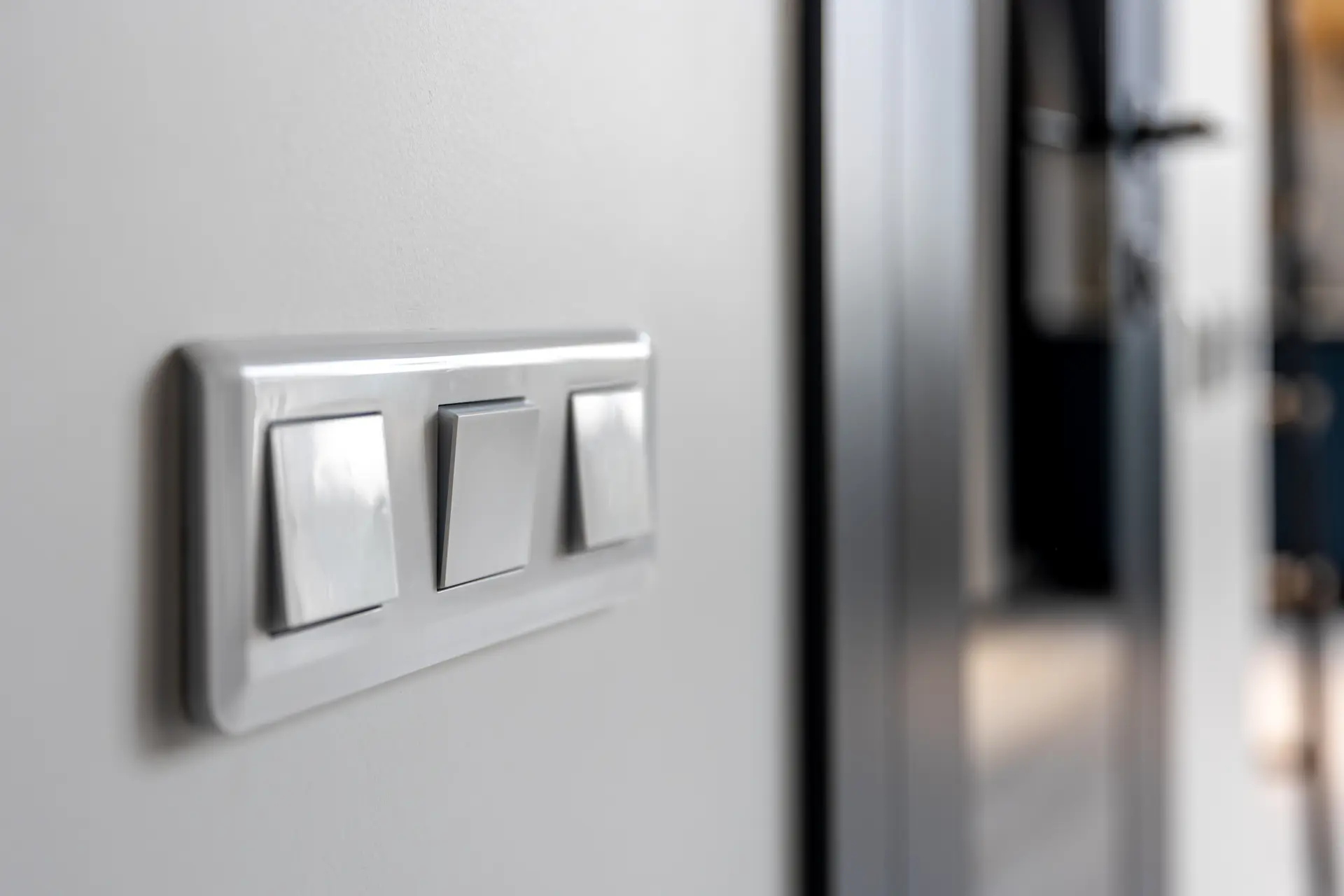Old fuse box or consumer unit
An old fuse box or consumer unit can struggle with the demands of modern life. Older units often use rewirable fuses with bits of fuse wire. These are slower to act than modern breakers and can be hard to reset safely. If your unit has a wooden back, cloth-insulated wires visible inside, or no main switch, it is likely past its best.
Modern consumer units have residual current devices and miniature circuit breakers. These cut the power quickly if there is a fault or an electric shock risk. They are also much easier to reset. A unit without these safety devices leaves you more exposed to harm. You may also notice mixed or messy labelling on the circuits, which can hint at piecemeal work over the years.
Another clue is its physical wear, for example, a yellowed case, broken cover clips, or missing blanks can allow dust to enter and increase risk. Warmth on the front of the unit is a red flag, and so is a humming sound from inside. Both can point to loose connections or overloaded parts.
Rubber or cloth covered cables
Many homes built before the 1960s used rubber or cloth-covered cables. Over time, rubber dries out and cracks. Cloth sheathing can fray or rot. When this happens, the copper inside may become exposed. Exposed conductors can arc, overheat, and spark, which is dangerous.
You may see these older cables around lofts, under stairs, or near the consumer unit. They can look dull, faded, or dusty compared with modern PVC cables, and if you touch them, flakes may come away. You might also notice old fabric tape around joins or ceramic cleats holding the wires in place, and these are strong indicators that the wiring is very old.

Old cable colours are another hint. Pre-2004 colour codes used red for live and black for neutral.
Modern cables use brown for live and blue for neutral. Finding both systems in the same home often means the wiring was updated in stages. Parts of the house may still rely on ageing cable runs that need replacing.
If you suspect rubber or cloth insulation, do not disturb it. Movement can make fragile insulation crumble. A qualified electrician can assess the extent of the issue and propose a plan to rewire affected circuits with modern PVC-insulated, low-smoke cables.
Burning smells or warm plates
A burning or fishy smell near sockets, switches, or light fittings is a serious warning. The odour can come and go as circuits heat and cool. It often means insulation is overheating or a connection is loose. Heat builds up and can char plastic or the dust around it, creating that sharp scent.
Warm or discoloured faceplates are also telling. A plate that is hot to the touch suggests high resistance at a terminal. This can happen when screws loosen or when the wrong cable size is used. You may see browning around the edges of the socket or small hairline cracks on the plastic. These marks should never be ignored.
Light fittings can suffer similar problems. A ceiling rose that smells odd after the lights have been on, or a pendant that shows sooty staining, may point to poor connections. Downlights installed without any proper clearances can also trap plenty of heat. This can harm nearby wiring and fittings over time.
Buzzing from switches or lights
Electrics should be quiet in use. A steady buzzing from a switch, dimmer, or light is not normal. It may mean a loose part, worn contacts, or a poor match between the dimmer and the lamp. While some dimmers make a faint sound with certain bulbs, a constant or loud buzz deserves attention.
Buzzing can also occur when a circuit is overloaded. When more current flows than the system was made for, components vibrate. This includes loose transformer housings in older low-voltage lighting. The sound might change as you raise or lower the dimmer level, which is another clue that the control or lamp is unsuitable.

Fluorescent fittings and older LED drivers may hum if they are failing. You might also see flicker at the same time. Flicker with noise often points to a driver or ballast on its way out. Left unchecked, overheating can follow, which can damage nearby cables.
If you hear buzzing, note which switch or light it comes from and when it occurs during the day. Try a known good bulb of the correct type, and if the noise remains, stop using that fitting and have it inspected.
Replacing the control gear or fixing a loose connection can stop the noise and reduce risk.
Breakers tripping often
Circuit breakers trip to protect you. An occasional trip after plugging in a faulty appliance is normal. Frequent tripping is not. If a breaker or residual current device cuts out again and again, it suggests a deeper fault. This might be an overloaded circuit, a damaged cable, or moisture in a fitting.
Overloads are common in kitchens and home offices. Many high-demand items on one ring circuit can push it past its limit. You may notice the trips happen at busy times, such as evenings when more devices are in use. Moving some loads to a different circuit can be a short-term fix, but it does not solve undersized wiring or poor design.
Nuisance trips can also result from deteriorated insulation. Tiny leakage currents build up and can cause the RCD to operate, but garden sockets, outdoor lights, and bathroom circuits are frequent culprits due to damp conditions. A pattern that links tripping to rain or showers is a useful clue.
If your home or property needs a complete rewire, give our team a call. We'll inspect the electrical units throughout the identify the problems and assess whether a rewire is the best option, then carry out the job safely. Give us a call today for further details.



